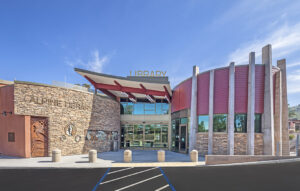The International Code Council worked with policymakers to support the provided resources. These resources will help communities:
- Update their energy codes
- Promote low-carbon construction materials
- Encourage energy-efficient retrofits and distributed energy generation including solar thermal and small-scale wind
Members of the Steel Framing Industry Association (SFIA), which represents the metal framing industry, have a positive view of the new law.
“The SFIA membership is excited about the opportunity to support the environmental agenda as outlined in the Inflation Reduction Act,” says Terry Westerman, vice president of marketing at ClarkDietrich, an SFIA member. Westerman is also a member of the SFIA’s newly formed Cold-Formed Steel (CFS) Sustainability Task Group. “Steel is the most recycled building material on the planet, and our association already supports industry stakeholders with its third-party verified industry wide EPD.”
$1 Billion to Improve Energy Codes
Building upon last year’s Infrastructure Investment and Jobs Act, the Inflation Reduction Act provides $1 billion to support jurisdictions seeking to adopt, update and improve the implementation of current energy codes.
More specifically, the new legislation supports codes and standards or local amendments that meet or exceed the 2021 International Energy Conservation Code (IECC), and zero-energy building codes, including codes and standards or local amendments that meet or exceed 2021 IECC’s net zero appendices.
SFIA Cold-Formed Steel Sustainability Task Group
The Steel Framing Industry Association (SFIA) recently launched a Cold-Formed Steel (CFS) Sustainability Task Group to help define sustainability as it pertains to the metal framing industry.
The goal of the SFIA task group is to align industry players on sustainability and take the lead in helping the industry meet the United States government’s developing green building goals for federally funded projects. BuildSteel will report regularly on the task group’s activities and continue to provide updates on the steel framing industry’s sustainability initiatives.
EPDs at the Center of Inflation Reduction Act
The bill makes further historic investments in sustainable construction, including $250 million through the U.S. Environmental Protection Agency (EPA) for work toward enhanced standardization for low-embodied carbon construction materials through environmental product declarations (EPDs), as well as assistance for the manufacturing industry to more widely use and validate EPDs.
The EPA will receive an additional $100 million to work with the U.S. Department of Transportation (DOT) and General Services Administration (GSA) on expanded labeling with EPDs for low-carbon construction materials used in building and infrastructure projects.
The GSA, DOT and the Federal Emergency Management Agency (FEMA) will be provided with roughly $4.2 billion in funding to incentivize low-carbon material use in federally funded projects.
SFIA Releases Industry Environmental Products Declaration for CFS
The Steel Framing Industry Association (SFIA) has released a new Environmental Product Declaration for Cold-Formed Steel Framing, a tool for contractors, building owners, architects and others delivering advanced building designs that meet the latest LEED™ and other sustainable rating systems, programs and standards.
SFIA EPD for CFS Framing — SCS-EPD-07103, version Sep. 7, 2021 (good through May 27, 2026) — can be seamlessly integrated into project specifications as an option with company-specific EPDs. SFIA offers a Specifications Review Service for this task. Architects can request the SFIA Specifications Review Service for steel framing, which is a completely free checkup.
Boost Energy Efficiency of Housing, Buildings
Steel framing was used in San Diego’s first zero net energy building, the Alpine Library in Alpine, Calif.
The Inflation Reduction Act further includes provisions to boost efficiency in both multi-family and single-family housing and extends tax credits for building efficiency, distributed generation, and energy storage (including through hydrogen as a medium). These provisions include a total of $9 billion in consumer-focused home energy rebate programs.
An additional program would provide $1 billion for a new grant program to make the U.S. Department of Housing and Urban Development-assisted housing more energy and water efficient, resilient, and sustainable.
The Code Council will continue to engage with the Administration and Congress to support additional provisions for community resilience and to expand incentives that enable jurisdictions to meet climate goals through a range of energy sources.
CFS Meets All Sustainability Requirements
Cold-formed steel (CFS) meets the highest sustainability requirements set in all major green building standards and rating programs, including the Leadership in Energy and Environmental Design (LEED®) from the U.S. Green Building Council, the National Green Building Standard (ICC-700) for residential buildings, ASHRAE Standard 189.1 for commercial construction and the International Green Construction Code (IgCC).
The American Iron and Steel Institute reports:
- Steel framing contains a minimum of 25% recycled steel and is continually and completely “remade without any loss of quality”
- Most other construction products can only be down-cycled into lower-quality products
- Steel framing minimizes construction site waste
‘Kick-Start’ for Green Construction Material
The recycling rate for steel used in general construction, which includes recycling cold-formed steel stud scrap material, is 74%.
“The Inflation Reduction Act makes historic investments to support U.S. communities seeking to update their building energy codes and to promote sustainable construction,” said Code Council Chief Executive Officer Dominic Sims, CBO.
“These efforts will cut consumers’ energy bills, significantly curb building emissions, and kick-start the market for green construction materials. The Code Council looks forward to working with industry, as well as federal, state, local, tribal, and territorial governments to ensure that these investments and incentives are utilized to their fullest potential.”
Article cited from BuildSteel



